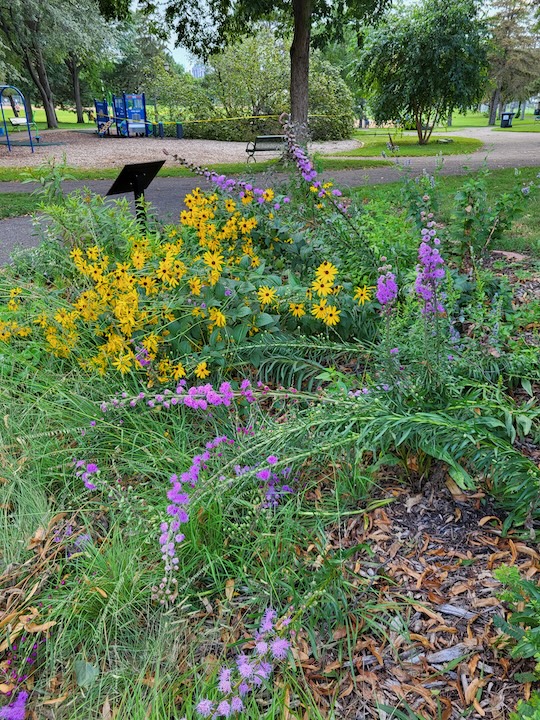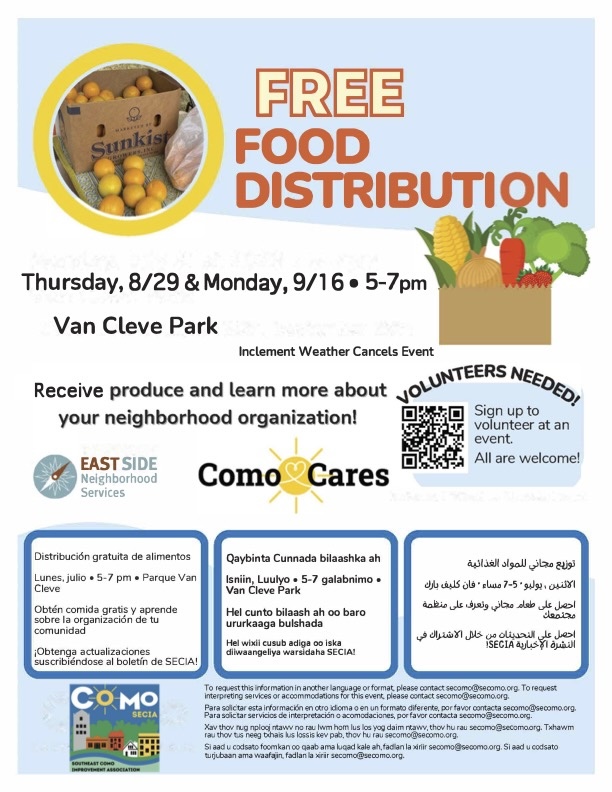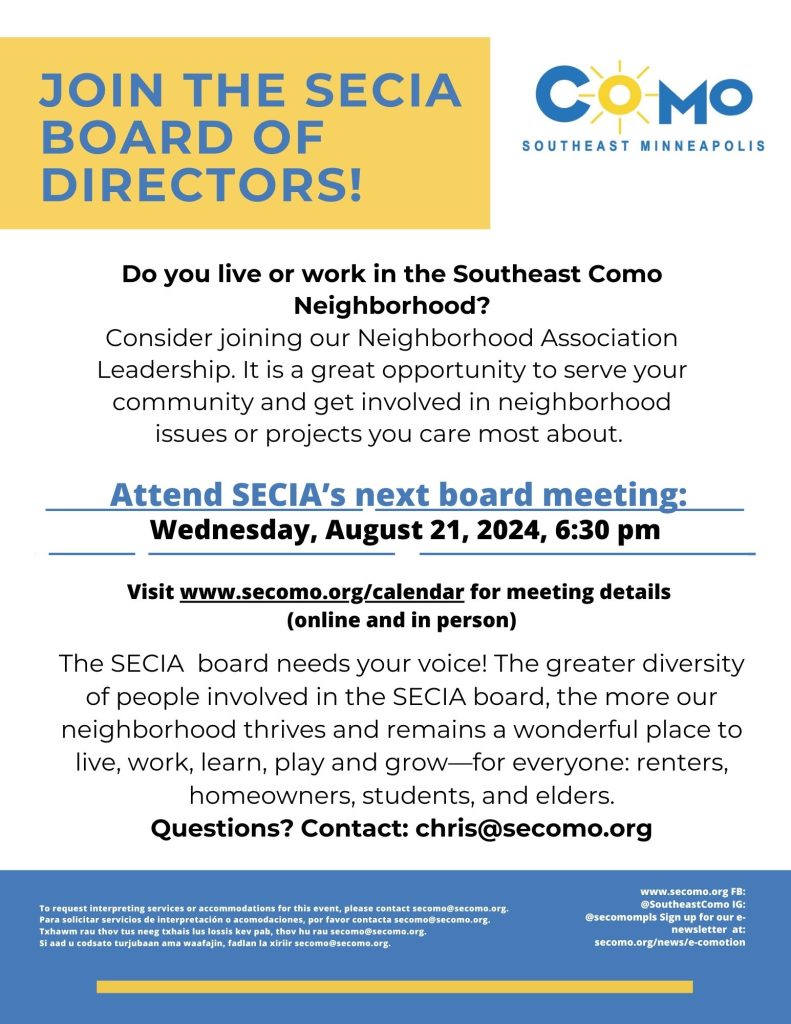
The Southeast Como Improvement Association (SECIA) now receives less than $30,000 annually from the city—a two-thirds reduction in its budget over the past decade.
By early 2020, SECIA’s capacity was stretched thin, and after that challenging year, the organization was forced to do even more with even fewer resources. To address these challenges, SECIA began collaborating with nearby neighborhood associations in early 2023 to find ways to improve efficiency and impact. This was made possible through a $20,000 grant from the City of Minneapolis and a $25,000 grant from the University of Minnesota’s Good Neighbor Fund.
This collaboration was driven by facts, not misleading narratives from those opposing change. After 18 months of discussions with other neighborhood organizations, financial analysis, legal consultation, and talks with the city, the SECIA board voted 2 to 1 to merge its administrative structure with the Marcy-Holmes and Nicollet Island-East Bank neighborhood associations. The board believes this merger is essential to sustain vital programs like the Como Cookout, Como Kids, and Como Cares.
A merger does not erase the Como neighborhood. Como’s identity and its programs will remain intact. Claims that Como will be “erased” or lose its identity are false. Yard signs with slogans like “Keep Como Going” imply that a merger threatens the neighborhood’s existence, but without a functioning organization, Como will struggle to move forward.
While some believe Como can remain independent, they must provide a realistic plan for meeting city requirements. In contrast, SECIA has shared detailed analyses on its website, demonstrating the feasibility of the merger as the best path forward for the neighborhood.
The Basics
Who: The neighborhood organizations of Como, Mid-City Industrial, Marcy-Holmes, University, and Nicollet Island-East Bank are considering a merger. This would form the city’s seventh neighborhood coalition, a proven method used by groups like the Longfellow Community Council and Nokomis-East Neighborhood Association to represent neighborhoods efficiently. Other coalitions include Standish-Ericsson, Field Regina Northrop, Hale Page Diamond Lake, and Lower Northeast.
What: The merged organization will handle administrative tasks—budgeting, human resources, insurance, financial reporting, tax filings, and city communication—freeing up local volunteers to focus on planning community-building events. The details of the merger agreement can be found here.
Where: The Mississippi River and the University of Minnesota connect the affected neighborhoods.
When: Voting starts on September 28th for Como residents and will remain open until October 1st. You can register to receive an electronic ballot here.
Why: The merger is necessary for several reasons:
- Sustainability: SECIA has been spending deficits from previous city funds and will run out of resources in a few years, making it impossible to operate as it has in the past.
- Financial: Centralizing administrative structures saves costs in rent, insurance, web hosting, etc. Financial data supporting this is found in the consultant report.
- Staffing: With many residents staying short-term, knowledgeable staff is crucial. Budget cuts make it hard for individual neighborhoods to retain full-time staff, but merging allows shared resources to maintain qualified staff and continue events like the Como Cookout.
- Successful examples: Merged organizations like the Longfellow Community Council have shown that this model works, providing staff and support for grant writing and community building.
- Shared Challenges: All potential merger partners have high numbers of renters, which can make community-building difficult. However, shared efforts can tackle issues like renters’ rights, housing costs, and climate change.
- Willing Partners: With $45,000 in grant funding to support the merger studies and legal logistics, several neighborhood partners see the value in merging, including increased political clout and the potential for new programs.
- How: The new organization will be governed by neighborhood-elected representatives. Local committees will continue addressing neighborhood-specific issues, ensuring communities retain a strong voice.
Change can be difficult, but it is necessary to adapt. This information aims to help you make an informed decision when voting.
Key Documents
- Report: East Bank Neighborhoods Partnership: Merging Organizations, Not Neighborhoods
- Presentation: East Bank Neighborhoods Partnership: Merging Organizations, Not Neighborhoods (to be presented in September 2024)
- Frequently Asked Questions
- Plan of Merger (approved by all 3 boards in August 2024)
- Plan of Merger Summary
- Exploratory Report by Willow Consulting (published October 2023)
- Partnership Staff Job Description
- University Neighborhoods Partnership grant application (2023, City of Minneapolis)
- University Neighborhoods Partnership grant application (2024, Good Neighbor Fund)
We welcome input from individuals and groups who oppose SECIA’s position on the proposed merger. You may have noticed yard signs urging people to vote “no” on the merger. Below, we’d like to present the statement they have shared. After reviewing their assertions, we encourage you to read our response, addressing each of their five key claims.
Reminder: the Vote No group is outlined in green:
RESPONSE I
- Como residents are not expected to volunteer for events in Nicollet Island or Marcy-Holmes, and vice versa. Each neighborhood will maintain its volunteer base—Como volunteers won’t be required to garden on Marcy-Holmes’ 5th Street SE or join safety walks in Nicollet Island-East Bank.
- This is not a distant organization. The proposed merger involves Como’s neighbors facing similar issues and collaborating with groups like Southeast Seniors and the University of Minnesota’s Office of Off-Campus Living.
- As for the concern about longer meetings, that won’t happen. There will not be four separate agendas, minutes, or reports. Instead, one unified set will be reviewed and approved, as seen in the city’s six existing combined associations.

RESPONSE II
- Insurance makes up 10% ($1,500) of SECIA’s $15,000 annual overhead, not just “a bit.” City requirements mandate both Liability and Directors & Officers insurance.
- Bookkeeping and payroll across the three organizations cost nearly $15,000 annually. A single payroll system would reduce SECIA’s costs by 66%.
- SECIA and MHNA maintain offices, costing $485 per month ($5,820 annually). A combined office would save SECIA $1,000 a year. Without an office, volunteers would need to store supplies at home.
- Each organization also maintains a separate website and social media presence, which is largely redundant. A merger would reduce Como’s costs by 75%.
- SECIA spends $420 annually on a phone line, MHNA pays $156, and NIEBNA pays $0.
- Merging would allow Como to stretch its resources further, using NRP funds for projects instead of overhead. SECIA’s current budget is only viable because it drains NRP Program funds to cover shortfalls.

RESPONSE III
- SECIA currently underpays its staff and relies heavily on interns with inconsistent results. A merger would provide fair wages without expecting staff to work overtime consistently.
- The claim that an event coordinator would schedule four events simultaneously is unrealistic and a false dilemma. This hasn’t happened in any of the six existing neighborhood coalitions, and it’s unlikely here. When was the last time multiple neighborhoods hosted Saturday evening events simultaneously?
- Dedicated volunteers already run many SECIA events without a paid event coordinator. There’s no need to scare Como residents with the unlikely scenario of an overworked coordinator managing four events at once.

RESPONSE IV
- Last year, two neighborhoods merged to form the Lower Northeast Neighborhood Association. Other merger discussions are ongoing in Minneapolis, but no decisions have been made yet.
- If formed, the East Bank Neighborhoods Partnership would be the 7th multi-neighborhood association, representing 22 neighborhoods (a quarter of all Minneapolis neighborhoods).
- However, what other neighborhoods do should not dictate what’s best for ours. Our decisions should be based on what serves our community’s best interests, not influenced by external examples.

FINAL RESPONSE
- SECIA operates on a shoestring budget with underpaid, overworked staff. The “Vote No” group’s only suggestion is to “budget well,” but without specific cuts or solutions. Currently, SECIA shares a windowless basement office in the Mid-City Industrial area, formerly a hearse storage facility.
- The University of Minnesota funds and organizes 75% of the Como Cookout, and both the University and MPRB have stated they will end their support by 2025 without increased financial and volunteer contributions.
- Additionally, 90% of the Como newsletter content is relevant to neighboring communities, except for meeting dates and times. Meeting information is found on the website.
PLEASE REQUEST A BALLOT
SECIA will be hosting a second Community Discussion of this board-approved merger on Thursday, September 19, 2024. This will be online via Zoom, and will begin at 6:30 pm. Please see our calendar for Zoom information.
There will be additional opportunities to engage at the upcoming Como Cookout. At the end of the Cookout, electronic ballots for Southeast Como community voting will be distributed by email. You can request a ballot here; you will receive it on September 28th.
- Voters will have 72 hours to complete their online ballot (the SECIA voting period ends at 3 pm on Tuesday, October 1, 2024).
- Ballots can be requested while the Como voting period is open, from September 28 – October 1.









